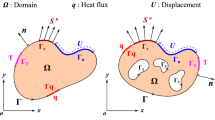Abstract
In this investigation, the conservative M-integral is extended to treat thermal-elastic, mixed mode problems. With it, stress intensity factors are obtained for cracks in homogeneous, isotropic materials, as well as isotropic and anisotropic, bimaterials. Excellent agreement is found between results determined in this study and those found in the literature. In addition, new results are obtained for interface cracks for a wide range of material properties and for a delamination in a composite material.
Similar content being viewed by others
References
Ashkenazi, D. (1999). Determination of Critical Interface Energy Release Rates for Bonded Elastic Materials. Ph.D. Thesis (in Hebrew), Tel Aviv University.
Atkinson, C. (1977). On quasistatic problems of cracks in a non-homogeneous elastic layer. Acta Mechanica 26, 103–113.
Banks-Sills, L. and Sherman, D. (1992). On the computation of stress intensity factors for three-dimensional geometries by means of the stiffness derivative and J-integral methods. International Journal of Fracture 53, 1–20.
Banks-Sills, L., Travitzky, N., Ashkenazi, D. and Eliasi, R. (1999). A methodology for measuring interface fracture toughness of composite materials. International Journal of Fracture 99, 143–161.
Banks-Sills, L. and Boniface, V. (2000). Fracture mechanics for an interface crack between a special pair of transversely isotropic materials. In: Multiscale Deformation and Fracture in Materials and Structures-The James R. Rice 60th Anniversary Volume. (Edited by T.-J. Chuang and J.W. Rudnicki). pp. 183–204. Kluwer Academic Publishers, Dordrecht.
Banks-Sills, L., Boniface, V. and Eliasi, R. (2003). Effect of residual stresses on delaminations in fiber reinforced composites. Interface Science 11, 339–348.
Banks-Sills, L. and Ishbir, C. (2004). A conservative integral for bimaterial notches subjected to thermal stresses. International Journal for Numerical Methods in Engineeering, to appear.
Bathe, K.J. (2001). ADINA-Automatic Dynamic Incremental Nonlinear Analysis System, Version 7.5, Adina Engineering, Inc. USA.
Brown, E.J. and Erdogan, F. (1968). Thermal stresses in bonded materials containing cuts on the interface. International Journal of Engineering Science 6, 517–529.
Brust, F.W., Nakagaki, M. and Springfield, C. (1989). Integral parameters for thermal fracture. Engineering Fracture Mechanics 33, 561–579.
Deng, X. (1993). General crack-tip fields for stationary and steadily growing interface cracks in anisotropic bimaterials. Journal of Applied Mechanics 60, 183–189.
Doroguy, A. and Banks-Sills, L. (2004). Shear loaded interface crack under the influence of friction-a finite difference solution. International Journal for Numerical Methods in Engineering, to appear.
Dundurs, J. (1969). Edge-bonded dissimilar orthogonal elastic wedges under normal and shear loading. Journal of Applied Mechanics 36, 650–652.
Erdogan, F. (1965). Stress distribution in bonded dissimilar materials with cracks. Journals of Applied Mechanics 32, 403–410.
Fung, Y.C. (1965). Foundation of Solid Mechanics. Prentice Hall, New Jersey, 354–355.
Hellen, T.K. and Cesari, F. (1979). On the solution of the centre cracked plate with a quadratic thermal gradient. Engineering Fracture Mechanics 12, 469–478.
Hutchinson, J.W., Mear, M.E. and Rice, J.R. (1987). Crack paralleling an interface between dissimilar materials. Journal of Applied Mechanics 54, 828–832.
Hutchinson, J.W. (1990). Mixed-mode fracture mechanics of interfaces. In: Metal-Ceramic Interfaces. (Edited by M. Rühle, A.G. Evans, M.F. Ashby and J.P. Hirth). pp. 295–301. Pergamon Press, Oxford.
Ikeda, T. and Sun, C.T. (2001). Stress intensity factor analysis for an interface crack between dissimilar isotropic materials under thermal stress. International Journal of Fracture 111, 229–249.
Ishikawa, H., Kitagawa, H. and Okamura, H. (1979). J integral of a mixed mode crack and its application. In Mechanical Behavior of Materials, Vol. 3, ICM-3, Cambridge, England, 447–455.
Kou, A.-Y. and Riccardella, P.D. (1987) Path-independent line integrals for steady-state, two-dimensional thermoelasticity. International Journal of Fracture 35, 71–79.
Lee, K.Y. and Shul, C.W. (1991). Determination of thermal stress intensity factor for an interface crack under vertical uniform heat flow. Engineering Fracture Mechanics 40, 1067–1074.
Li, F.Z., Shih, C.F. and Needleman, A. (1985). A comparison of methods for calculating energy release rates. Engineering Fracture Mechanics 21, 405–421.
O’Dowd, N.P., Shih, F.C. and Stout, M.G. (1992). Test geometries for measureing interfacial fracture toughness. International Journal of Solids and Structures 29, 571–589.
Paley, M. and Aboudi, J. (1992). Micromechanical analysis of composites by the generalized cells model. Mechanics of Materials 14, 127–139.
Qian, Z.Q. and Akisanya, A.R. (1998). Analysis of free-edge stress and displacement fields in scarf joints subjected to a uniform change in temperature. Fatigue and Fracture of Engineering Materials and Structures 21, 687–703.
Rice, J.R. (1968). A path independent integral and the approximate analysis of strain concentration by notches and cracks. Journal of Applied Mechanics 35, 379–386.
Rice, J.R. (1988). Elastic fracture mechanics concepts for interfacial cracks. Journal of Applied Mechanics 55, 98–103.
Rice, J.R., Suo, Z. and Wang, J.-S. (1990). Mechanics and thermodynamics of brittle interface failure in bimaterial systems. In: Metal-Ceramic Interfaces. (Edited by M. Rühle, A.G. Evans, M.F. Ashby and J.P. Hirth), pp. 269–294. Pergamon Press, Oxford.
Shih, C.F., Moran, B. and Nakamura, T. (1986). Energy release rate along a three-dimensional crack front in a thermally stressed body. International Journal of Fracture 30, 79–102.
Suga, T., Elssner, G. and Schmauder, S. (1988). Composite parameters and mechanical compatibility of material joints. Journal of Composite Materials 22, 917–934.
Ting, T.C.T. (1996). Anisotropic Elasticity-Theory and Applications. Oxford University Press, Oxford.
Wilson, W.K. and Yu, I.-W. (1979). The use of the J-integral in thermal stress crack problems. International Journal of Fracture 15, 377–387.
Wilson, R.I. and Meguid, S.A. (1995). On the determination of mixed mode stress intensity factors of an angled crack in a disc using FEM. Finite Elements in Analysis and Design 18, 433–438.
Yau, J.F., Wang, S.S. and Corten, H.T. (1980). A mixed-mode crack analysis of isotropic solids using conservation laws of elasticity. Journal of Applied Mechanics 47, 335–341.
Yau, J.F. and Wang, S.S. (1984). An analysis of interface cracks between dissimilar isotropic materials using conservation integrals in elasticity. Enginering Fracture Mechanics 20, 423–432.
Yosibash, Z. (1998). Thermal generalized stress intensity factors in 2-D domains. Computer Methods in Applied Mechanics and Engineering 157, 365–385.
Author information
Authors and Affiliations
Rights and permissions
About this article
Cite this article
Banks-Sills, L., Dolev, O. The conservative M-integral for thermal-elastic problems. Int J Fract 125, 149–170 (2004). https://doi.org/10.1023/B:FRAC.0000021065.46630.4d
Issue Date:
DOI: https://doi.org/10.1023/B:FRAC.0000021065.46630.4d




